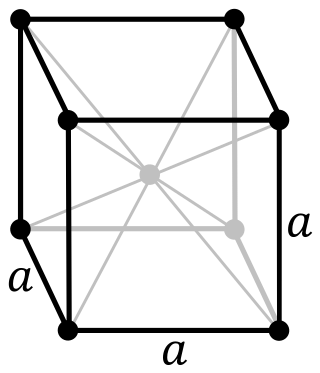Related Research Articles

Bohrium is a synthetic chemical element; it has symbol Bh and atomic number 107. It is named after Danish physicist Niels Bohr. As a synthetic element, it can be created in particle accelerators but is not found in nature. All known isotopes of bohrium are highly radioactive; the most stable known isotope is 270Bh with a half-life of approximately 2.4 minutes, though the unconfirmed 278Bh may have a longer half-life of about 11.5 minutes.

Meitnerium is a synthetic chemical element; it has symbol Mt and atomic number 109. It is an extremely radioactive synthetic element. The most stable known isotope, meitnerium-278, has a half-life of 4.5 seconds, although the unconfirmed meitnerium-282 may have a longer half-life of 67 seconds. The GSI Helmholtz Centre for Heavy Ion Research near Darmstadt, Germany, first created this element in 1982. It is named after Lise Meitner.

The neutron is a subatomic particle, symbol
n
or
n0
, which has a neutral charge, and a mass slightly greater than that of a proton. Protons and neutrons constitute the nuclei of atoms. Since protons and neutrons behave similarly within the nucleus, they are both referred to as nucleons. Nucleons have a mass of approximately one atomic mass unit, or dalton. Their properties and interactions are described by nuclear physics. Protons and neutrons are not elementary particles; each is composed of three quarks.

Nuclear fission is a reaction in which the nucleus of an atom splits into two or more smaller nuclei. The fission process often produces gamma photons, and releases a very large amount of energy even by the energetic standards of radioactive decay.
Livermorium is a synthetic chemical element; it has symbol Lv and atomic number 116. It is an extremely radioactive element that has only been created in a laboratory setting and has not been observed in nature. The element is named after the Lawrence Livermore National Laboratory in the United States, which collaborated with the Joint Institute for Nuclear Research (JINR) in Dubna, Russia, to discover livermorium during experiments conducted between 2000 and 2006. The name of the laboratory refers to the city of Livermore, California, where it is located, which in turn was named after the rancher and landowner Robert Livermore. The name was adopted by IUPAC on May 30, 2012. Five isotopes of livermorium are known, with mass numbers of 288 and 290–293 inclusive; the longest-lived among them is livermorium-293 with a half-life of about 60 milliseconds. A sixth possible isotope with mass number 294 has been reported but not yet confirmed.

In nuclear physics, the island of stability is a predicted set of isotopes of superheavy elements that may have considerably longer half-lives than known isotopes of these elements. It is predicted to appear as an "island" in the chart of nuclides, separated from known stable and long-lived primordial radionuclides. Its theoretical existence is attributed to stabilizing effects of predicted "magic numbers" of protons and neutrons in the superheavy mass region.

Unbinilium, also known as eka-radium or element 120, is a hypothetical chemical element; it has symbol Ubn and atomic number 120. Unbinilium and Ubn are the temporary systematic IUPAC name and symbol, which are used until the element is discovered, confirmed, and a permanent name is decided upon. In the periodic table of the elements, it is expected to be an s-block element, an alkaline earth metal, and the second element in the eighth period. It has attracted attention because of some predictions that it may be in the island of stability.
Flerovium is a superheavy synthetic chemical element; it has symbol Fl and atomic number 114. It is an extremely radioactive synthetic element, named after the Flerov Laboratory of Nuclear Reactions of the Joint Institute for Nuclear Research in Dubna, Russia, where the element was discovered in 1999. The lab's name, in turn, honours Russian physicist Georgy Flyorov. IUPAC adopted the name on 30 May 2012. The name and symbol had previously been proposed for element 102 (nobelium), but was not accepted by IUPAC at that time.

Spontaneous fission (SF) is a form of radioactive decay in which a heavy atomic nucleus splits into two or more lighter nuclei. In contrast to induced fission, there is no inciting particle to trigger the decay; it is a purely probabilistic process.
In nuclear engineering, a prompt neutron is a neutron immediately emitted by a nuclear fission event, as opposed to a delayed neutron decay which can occur within the same context, emitted after beta decay of one of the fission products anytime from a few milliseconds to a few minutes later.
Unbibium, also known as element 122 or eka-thorium, is a hypothetical chemical element; it has placeholder symbol Ubb and atomic number 122. Unbibium and Ubb are the temporary systematic IUPAC name and symbol respectively, which are used until the element is discovered, confirmed, and a permanent name is decided upon. In the periodic table of the elements, it is expected to follow unbiunium as the second element of the superactinides and the fourth element of the 8th period. Similarly to unbiunium, it is expected to fall within the range of the island of stability, potentially conferring additional stability on some isotopes, especially 306Ubb which is expected to have a magic number of neutrons (184).

Cluster decay, also named heavy particle radioactivity, heavy ion radioactivity or heavy cluster decay, is a rare type of nuclear decay in which an atomic nucleus emits a small "cluster" of neutrons and protons, more than in an alpha particle, but less than a typical binary fission fragment. Ternary fission into three fragments also produces products in the cluster size. The loss of protons from the parent nucleus changes it to the nucleus of a different element, the daughter, with a mass number Ad = A − Ae and atomic number Zd = Z − Ze, where Ae = Ne + Ze. For example:
Naturally occurring zirconium (40Zr) is composed of four stable isotopes (of which one may in the future be found radioactive), and one very long-lived radioisotope (96Zr), a primordial nuclide that decays via double beta decay with an observed half-life of 2.0×1019 years; it can also undergo single beta decay, which is not yet observed, but the theoretically predicted value of t1/2 is 2.4×1020 years. The second most stable radioisotope is 93Zr, which has a half-life of 1.53 million years. Thirty other radioisotopes have been observed. All have half-lives less than a day except for 95Zr (64.02 days), 88Zr (83.4 days), and 89Zr (78.41 hours). The primary decay mode is electron capture for isotopes lighter than 92Zr, and the primary mode for heavier isotopes is beta decay.
Bohrium (107Bh) is an artificial element. Like all artificial elements, it has no stable isotopes, and a standard atomic weight cannot be given. The first isotope to be synthesized was 262Bh in 1981. There are 11 known isotopes ranging from 260Bh to 274Bh, and 1 isomer, 262mBh. The longest-lived isotope is 270Bh with a half-life of 2.4 minutes, although the unconfirmed 278Bh may have an even longer half-life of about 690 seconds.
Darmstadtium (110Ds) is a synthetic element, and thus a standard atomic weight cannot be given. Like all synthetic elements, it has no stable isotopes. The first isotope to be synthesized was 269Ds in 1994. There are 11 known radioisotopes from 267Ds to 281Ds and 2 or 3 known isomers. The longest-lived isotope is 281Ds with a half-life of 14 seconds.

Nuclear binding energy in experimental physics is the minimum energy that is required to disassemble the nucleus of an atom into its constituent protons and neutrons, known collectively as nucleons. The binding energy for stable nuclei is always a positive number, as the nucleus must gain energy for the nucleons to move apart from each other. Nucleons are attracted to each other by the strong nuclear force. In theoretical nuclear physics, the nuclear binding energy is considered a negative number. In this context it represents the energy of the nucleus relative to the energy of the constituent nucleons when they are infinitely far apart. Both the experimental and theoretical views are equivalent, with slightly different emphasis on what the binding energy means.

Nucleon pair breaking in fission has been an important topic in nuclear physics for decades. "Nucleon pair" refers to nucleon pairing effects which strongly influence the nuclear properties of a nuclide.

Modesto Montoya is a nuclear physicist and former president of the Peruvian Institute for Nuclear Energy in Lima, Peru. He is a former president and current member of the Peruvian Academy of Nuclear Sciences, former president of the Peruvian Physical Society and member for Peruvian National Academy of Sciences. In 2021, he became an advisor to President Pedro Castillo on science matters. He served as minister of the environment of Peru.
Dorin Mircea Stelian Poenaru is a Romanian nuclear physicist and engineer. He contributed to the theory of heavy particle radioactivity.
Unbiunium, also known as eka-actinium or element 121, is a hypothetical chemical element; it has symbol Ubu and atomic number 121. Unbiunium and Ubu are the temporary systematic IUPAC name and symbol respectively, which are used until the element is discovered, confirmed, and a permanent name is decided upon. In the periodic table of the elements, it is expected to be the first of the superactinides, and the third element in the eighth period. It has attracted attention because of some predictions that it may be in the island of stability. It is also likely to be the first of a new g-block of elements.
References
- ↑ C. Signarbieux et al.. "Evidence for nucleon pair breaking even in the coldest scission configurations of 234U and 236U", Journal de Physique Lettres Vol 42, No 19 /1981, doi : 10.1051/jphyslet:019810042019043700, pp. 437-440
- ↑ M. Montoya. "Mass and kinetic energy distribution in cold fission of 233U, 235U and 239Pu induced by thermal neutrons", Zeitschrift für Physik A, Springer Berlin / Heidelberg, Vol 319, No 2 / June, 1984, doi : 10.1007/BF01415636, pp. 219-225
- ↑ A Sandulescu et al. "The cold fission of 248Cm", Journal of Physics. G: Nuclear and Particle. Physics, Volume 22/ 1996, doi : 10.1088/0954-3899/22/7/003, pp. L87-L94
- ↑ S Misicu et al. "Orientations of fragments emitted in binary cold fission of 252Cf", Journal Physics G: Nuclear and Particle Physics, Volume 28 /October, 2002, doi : 10.1088/0954-3899/28/11/309, pp. 2861-2874
- ↑ Dorin N Poenaru et al. "Cold fission as heavy ion emission", Zeitschrift für Physik A, Springer Berlin / Heidelberg, Vol 328, No 3 / 1987, doi : 10.1007/BF01290499, pp. 309-314
- ↑ Dorin N Poenaru, M. Ivascu, Walter Greiner "Unified approach of alpha-decay, heavy ion emission and cold fission", Chapter 7 of thed book Particle Emission from Nuclei, Vol. III: Fission and Beta-Delayed Decay Modes (CRC Press, Boca Raton, Florida, 1989), pp. 203-235.
- ↑ Gönnenwein, F.; Börsig, B. (1991). "Tip model of cold fission". Nuclear Physics A. 530 (1): 27–57. Bibcode:1991NuPhA.530...27G. doi:10.1016/0375-9474(91)90754-T.
- ↑ Duarte, S. B.; Rodríguez, O.; Tavares, O. A. P.; Gonçalves, M.; García, F.; Guzmán, F. (1998). "Cold fission description with constant and varying mass asymmetries". Physical Review C. 57 (5): 2516–2522. Bibcode:1998PhRvC..57.2516D. doi:10.1103/PhysRevC.57.2516.
- ↑ Modesto Montoya, "Shell and coulomb effects in thermal neutron induced cold fission of U-233, U-235, and Pu-239", Radiation Effects and Defects in Solids, Volume 93, Issue 1–4 March 1986, pages 9 - 12
- ↑ Montoya, M.; Hasse, R. W.; Koczon, P. (1986). "Coulomb effects in low energy fission". Zeitschrift für Physik A. 325 (3): 357–362. Bibcode:1986ZPhyA.325..357M. doi:10.1007/BF01294620. S2CID 119745507.